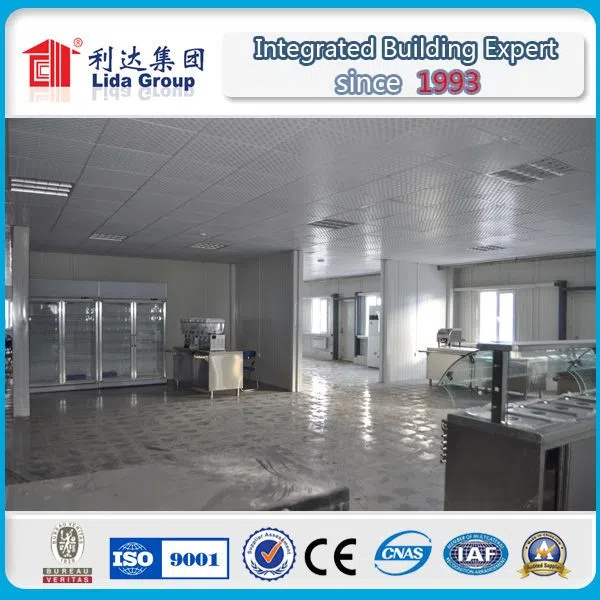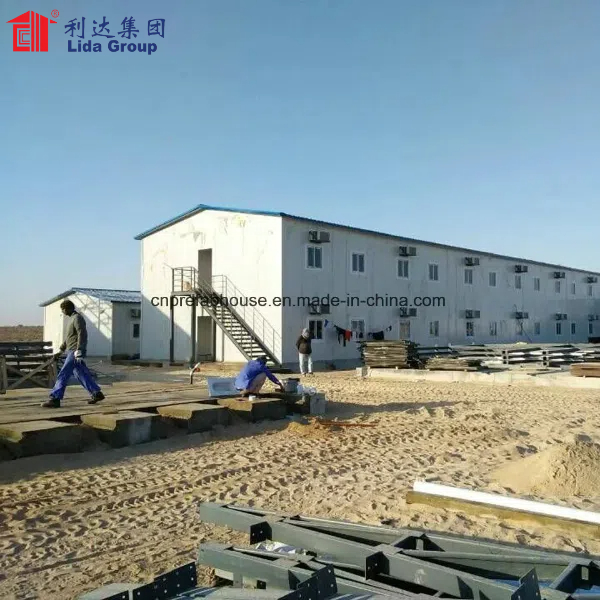In the contemporary industrial landscape, the demand for efficient labor camps has become increasingly critical. Industries such as construction, mining, and oil and gas often require temporary accommodations for their workforce, especially in remote locations. Lida Group, a leader in the prefabricated housing sector, offers innovative solutions that address the unique challenges of designing labor camps. This article explores the features, benefits, and applications of Lida Group’s prefab house solutions, emphasizing their role in creating efficient and comfortable labor accommodation.
Understanding Prefab Houses
What Are Prefab Houses?
Prefab houses, or prefabricated houses, are structures that are manufactured off-site in a controlled environment and assembled on-site. This method contrasts with traditional building practices, which typically involve extensive on-site labor and longer timelines. Lida Group’s prefab houses are designed to provide high-quality, durable, and flexible living spaces tailored to the needs of workers in various sectors.
Key Features of Lida Group’s Prefab Houses
- Rapid Construction: One of the most significant advantages of prefab houses is the speed of construction. While the modular units are being manufactured, site preparation can occur simultaneously, allowing for quicker project completion.
- Quality Assurance: Factory production allows for rigorous quality control, ensuring that all components meet high safety and performance standards.
- Cost-Effectiveness: The streamlined production process typically results in lower labor and material costs, making prefab houses a budget-friendly option for labor accommodation.
- Customization: Lida Group offers a wide range of designs and configurations, allowing clients to customize their prefab houses to fit specific requirements.
- Sustainability: Many of Lida Group’s prefab houses are designed with eco-friendly materials and energy-efficient systems, promoting sustainable construction practices.
The Importance of Efficient Labor Camps
1. Improved Worker Well-Being
Comfortable living conditions are essential for the mental and physical health of workers:
- Stress Reduction: Well-designed living spaces help alleviate stress, contributing to better mental health and overall job satisfaction.
- Encouraging Healthy Lifestyles: Comfortable accommodations can promote physical activity and social interaction, which are vital for maintaining a healthy lifestyle.
2. Increased Productivity
Worker productivity is closely linked to their living conditions:
- Better Work-Life Balance: Comfortable living spaces allow workers to recharge after long shifts, leading to higher morale and productivity.
- Reduced Turnover Rates: Improved living conditions can lead to enhanced job satisfaction, resulting in lower turnover rates and associated costs for employers.
3. Enhanced Community Spirit
Efficient labor camps foster a sense of community among workers:
- Social Interaction: Shared communal spaces in prefab houses encourage socializing, helping to build camaraderie among workers.
- Support Networks: A positive living environment can contribute to the formation of support networks, which are essential for workers in challenging remote environments.
Lida Group’s Innovations in Designing Labor Camps
1. Design and Layout
Lida Group focuses on creating prefab houses that prioritize comfort and efficiency:
- Spacious Interiors: The design of Lida Group’s prefab houses includes spacious interiors that allow for comfortable movement and living.
- Natural Light: Large windows are incorporated into the design to maximize natural light, creating a pleasant and uplifting living environment.
2. Modern Amenities
Lida Group’s prefab houses come equipped with essential amenities that enhance comfort:
- Fully Equipped Kitchens: Each unit can include a kitchen with modern appliances, allowing workers to prepare their meals and save on food costs.
- Private Bathrooms: Having private bathrooms enhances comfort and hygiene, contributing to the overall well-being of residents.
- Comfortable Furnishings: Lida Group provides high-quality furnishings that promote relaxation and comfort, including ergonomic beds and seating.
3. Energy Efficiency
Energy-efficient designs are a cornerstone of Lida Group’s prefab houses:
- High-Quality Insulation: Effective insulation helps regulate indoor temperatures, reducing energy consumption for heating and cooling.
- Renewable Energy Solutions: Incorporating solar panels and energy-efficient appliances can further lower operational costs and increase the sustainability of living conditions.
4. Flexibility and Customization
Lida Group’s prefab houses are designed with flexibility in mind:
- Customizable Configurations: Clients can choose layouts that best suit their workforce, including options for individual units or shared accommodations.
- Expandable Designs: As the workforce grows or changes, Lida Group’s prefab houses can be easily expanded or reconfigured to meet new demands.
The Design Process for Labor Camps
1. Planning and Needs Assessment
The foundation of successful labor camp projects begins with thorough planning:
- Understanding Workforce Needs: Engaging with clients to assess their specific requirements, including the number of occupants and desired amenities, is crucial for effective design.
- Site Evaluation: Evaluating the site for accessibility, environmental conditions, and available resources helps inform the design process.
2. Modular Production
Once the design is finalized, the construction process begins off-site:
- Factory Production: Modular units are constructed in a controlled environment, allowing for precision and quality control. This typically involves assembling walls, roofs, and internal fixtures.
- Quality Assurance: Each unit undergoes rigorous inspections to ensure safety and quality standards are met before being transported to the site.
3. Transportation and Assembly
The next phase involves transporting the modular units to the construction site:
- Logistics Management: Coordinating transportation logistics is essential to ensure that units arrive on time and in good condition.
- On-Site Assembly: Once on-site, the units can be quickly assembled into the desired configuration, often within days.
4. Final Touches
After assembly, the final steps include:
- Interior Finishing: Adding furnishings and appliances ensures that the prefab houses are ready for occupancy.
- Site Preparation: Ensuring that the surrounding area is safe and accessible for workers, including landscaping and utility connections.
Sustainability in Lida Group’s Prefab Houses
1. Eco-Friendly Materials
Sustainability is a core principle in the design and construction of prefab houses:
- Recycled Materials: Utilizing recycled materials can significantly reduce the environmental impact of construction.
- Sustainable Sourcing: Ensuring that any additional materials used for modifications are sourced responsibly enhances the overall sustainability of the project.
2. Energy Efficiency
Lida Group’s prefab houses are designed with energy efficiency in mind:
- High-Quality Insulation: Effective insulation helps regulate indoor temperatures, reducing energy consumption for heating and cooling.
- Renewable Energy Solutions: Incorporating solar panels or other renewable energy technologies can minimize reliance on fossil fuels and lower operational costs.
3. Waste Reduction
The modular construction process inherently reduces waste:
- Controlled Environment: Building in a factory setting allows for better management of materials and minimizes waste compared to traditional construction sites.
- Recycling Programs: Implementing recycling initiatives for any waste generated during construction can further reduce environmental impact.
Applications of Lida Group’s Prefab Houses
1. Labor Camps
Lida Group’s prefab houses are ideal for labor camps in various industries:
- Immediate Housing Solutions: They provide quick accommodation for workers involved in large-scale projects, ensuring comfortable living conditions.
- Adaptable Designs: The modular nature allows for easy reconfiguration based on changing workforce needs.
2. Educational Facilities
Prefab houses can also serve as educational facilities:
- Classrooms and Offices: Lida Group can create flexible classroom spaces and administrative offices that meet the needs of educational institutions.
- Affordable Expansion: The cost-effectiveness of prefab houses makes them an attractive option for schools seeking to expand or build new facilities on a budget.
3. Healthcare Facilities
The healthcare sector can benefit significantly from Lida Group’s prefab houses:
- Temporary Clinics: In times of crisis, such as pandemics or natural disasters, these homes can be quickly deployed as temporary clinics or vaccination centers.
- Long-Term Facilities: Permanent healthcare facilities can also be constructed using sustainable methods, ensuring they meet community needs efficiently.
4. Disaster Relief
Lida Group’s prefab houses are invaluable in disaster relief efforts:
- Rapid Deployment: After natural disasters, prefab homes can be quickly assembled to provide temporary housing for displaced individuals.
- Flexible Solutions: They can be customized to meet the specific needs of affected communities, ensuring adequate shelter is available.
Case Studies: Successful Prefab House Projects
Case Study 1: Worker Accommodation for Construction
Challenge: A major construction company needed a labor camp to accommodate workers on a large infrastructure project.
Solution: The company opted for prefab houses designed by Lida Group, featuring modern living units and communal facilities.
Outcome: The project was completed ahead of schedule, and worker satisfaction significantly improved, leading to increased productivity and reduced turnover rates.
Case Study 2: Educational Facility Expansion
Challenge: A local school district needed to expand its facilities to accommodate a growing student population.
Solution: Lida Group provided prefab classrooms that could be easily assembled on-site, providing additional space for learning.
Outcome: The new classrooms were ready for occupancy in a fraction of the time it would have taken for traditional construction, allowing the school to meet its needs promptly.
Case Study 3: Disaster Relief Housing
Challenge: After a natural disaster, there was an urgent need for temporary housing for displaced individuals.
Solution: Lida Group rapidly deployed prefab homes to provide shelter for affected families, with each unit designed to accommodate basic living needs.
Outcome: The quick deployment of prefab homes helped restore stability for displaced individuals and provided a safe living environment during recovery efforts.
The Future of Prefab Houses in Labor Camps
Trends Shaping the Industry
The future of prefab houses will be influenced by several key trends:
1. Increased Demand for Sustainable Practices
As environmental awareness continues to grow, industries are under pressure to adopt sustainable practices:
- Eco-Friendly Solutions: Companies prioritizing sustainability will appeal to a growing market of environmentally conscious consumers.
- Regulatory Changes: Governments may implement stricter regulations on environmental impact, driving the need for sustainable building solutions.
2. Technological Advancements
Advancements in technology will enhance the efficiency of prefab houses:
- Smart Technologies: The integration of IoT devices will enable real-time monitoring and optimization of living conditions and resource usage.
- Automation: Automation in production processes can improve efficiency and reduce labor costs.
3. Customization and Modularity
The demand for customizable and modular designs will continue to grow:
- Flexible Accommodation Solutions: Businesses will increasingly require prefab houses that can be easily adapted to changing operational needs.
- Rapid Deployment: Prefabricated solutions will allow for quick construction and minimal disruption, catering to the fast-paced demands of modern industries.
Commitment to Innovation
Leading firms in the prefab housing market, including Lida Group, remain dedicated to innovation:
- Research and Development: Continuous investment in R&D ensures that companies stay at the forefront of technological advancements in prefab construction.
- Client Collaboration: By working closely with clients, firms can develop tailored solutions that meet specific operational requirements and sustainability goals.
Conclusion
Lida Group’s prefab house solutions represent a significant advancement in designing efficient labor camps. Their focus on modern amenities, rapid deployment, and sustainability makes them an ideal choice for various industries, from construction to education and disaster relief.
As the demand for temporary and semi-permanent worker accommodation continues to grow, prefab houses will play a crucial role in enhancing living conditions and providing effective solutions. The future of prefab housing is promising, with the potential for innovation and improvement in living standards for diverse populations.
In an era where flexibility and environmental responsibility are paramount, Lida Group’s prefab houses provide an innovative solution to the challenges of labor accommodation. Through strategic investments and a commitment to excellence, the prefab housing sector is poised to enhance operational capabilities for its clients and contribute positively to the evolution of housing solutions. The journey toward a more efficient and sustainable future in labor accommodation is just beginning, and the potential for growth and innovation is limitless.
Contact Us
Post time: Jun-10-2025


